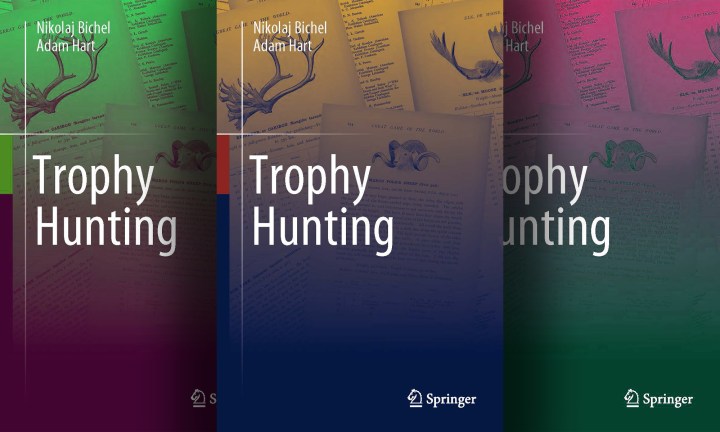BOOK REVIEW
The polarising issue of trophy hunting: digging deeper and dispelling a wealth of misinformation

Hunting, especially trophy hunting, is a thorny issue that has taken centre stage in countries such as the UK in the wake of the slaying of a Zimbabwean lion named Cecil in 2015. A recent book takes an objective look at the topic and reaches conclusions that both hunters and animal welfare activists will find discomfiting.
Trophy Hunting by Nikolaj Bichel and Adam Hart is a thorough, insightful and up-to-date rendering of an area that stirs more raw emotion than almost any other conservation issue. It stands out like a broad-side kudu bull from the hectoring herd of public discourse on the topic, its pointed horns of enquiry spiralling above the dust of misinformation.
Hunters and animal welfare activists are both in the authors’ crosshairs in this objective account of a polarising subject where “facts” that don’t fit a specific narrative are often ignored despite the clear spoor that is visible in the trail of truth.
“Trophy hunting can rile people up, and offend them, like very few other topics. The lack of understanding between hunting’s proponents and opponents is more pronounced than ever and attempts at reasonable debate often fail,” the authors write.
The two sides hardly ever engage and when they do, it’s usually in a rage, and it is animal welfare activists who generally charge like an angry hippo.
The authors have reviewed the debates from all sides, and have extensively reviewed the academic literature, supplemented with their own interviews and fieldwork. This is a nuanced look at the subject that stretches from pre-history to our current conflicts over trophy hunting.
The authors define trophy hunting as “any hunting of a nonhuman animal where part of the animal is kept for personal display purposes and souvenir”. They admit this has its downsides as many hunters who do just that do not regard themselves as “trophy hunters”. But it mounts the subject in a way that can clearly be seen. For example, the authors cite research that suggests Americans are generally accepting of hunting for food but see red if it is done in pursuit of a trophy instead of meat. This is true even among hunters.
“A 2015 study among California hunters conducted by Responsive Management reported that survey respondents, when presented with five options for the primary motivation to hunt, chose, in order of popularity: sport or recreation (32%); meat (30%); the company of family and friends (21%); closeness to nature (15%); and a long way behind, in last place, the trophy (1%),” the authors note.
Trophies may be low on the list as a motivating factor among hunters, but it is very high on the radar screen of animal rights activists. This is especially the case with Africa. The continent’s megafauna simply strikes a chord with mostly affluent suburbanites, whose own children are never at risk of a big animal attack, giving rise to a romanticisation of such wildlife that few Africans share.
Indeed, some animals are more equal than others. Impala hunting for example does not touch nerves in the same way. Nor pointedly does trophy hunting in the UK.
Conservation conundrum
On the African continent, the rationale usually evoked in defence of trophy hunting is that it brings social and economic benefits which in turn translate into conservation benefits. This is especially true of the big, dangerous critters which nobody likes to share space with if they can avoid it.
On this score, the authors cite the US scientist Craig Packer, who is widely regarded as the world’s foremost expert on lions:
“Ask most rural Tanzanians what they think about wildlife, and they’ll probably tell you that if they can’t eat it, they’d just as soon eradicate it. Elephants and Lions? The two most hated species in the country.” (Italics added).
Still, the authors offer some withering criticism of trophy hunting as a conservation paradigm while also acknowledging the economic and conservation successes linked to the practice.
“Hunters are often conservationists, and they may even work with conservation professionally, but when they go hunting, they are motivated by something else,” the authors pointedly note (italics added).
“For the trophy hunters who pay a fortune to hunt exotic game abroad, the conservation-as-motivation appears even more dubious. If someone claims to pay tens of thousands of dollars to go to Africa to shoot a lion mainly because of a desire to conserve lions, then why not just dispense with the hassle of travelling and hunting altogether and donate the money directly to lion conservation? It is, after all, usually not the shooting of a lion that contributes to conservation but the money that is paid for doing so. Paying $50,000 without shooting a lion usually does more for lion conservation than paying $50,000 for shooting one, and with a much-reduced carbon footprint.”
A positive conservation outcome from this perspective is rather like bycatch. It may be a net result, but is hardly the aim of the exercise.
It’s also important to highlight that the authors say more than once that hunters are often “conservationists”. One of the misleading ways the issue is framed by animal welfare activists is as a conflict between “hunters” and “conservationists” — as if only the animal welfare crowd is interested in conservation, which covers a broad range of issues including consumptive use, pollution, climate change and habitat loss. This reviewer has drawn attention to this point before and believes elements from the two sides can rightly wear the “conservationist” label. The roots of both are found in the soil of a similar history, but they have branched off from the same trunk in different directions.
The authors — based on empirical evidence — recognise the conservation dividends that flow from trophy hunting in some situations, while also pointing to those that are more of a liability than an asset.
“Trophy hunting is an extraordinarily complex topic. It involves numerous species (and in many cases, different populations of species and subspecies) across multiple countries and different land ownerships and land use categories (from community lands to hunting concessions and private reserves). There is no aspect of trophy hunting that is straightforward, and it is not possible to state whether ‘trophy hunting’ is good or bad for conservation,” (Italics added).
This is a conclusion the authors reached from pain-staking research viewed through the penetrating prism of objectivity rather than the distorting lens of emotion.
“The idea behind trophy hunting in Africa, and indeed many other locations, is that by letting hunting tourists pay to shoot a limited number of carefully selected individuals in a population, funding is obtained that can be used to protect wildlife species and habitats and support local economies. This prevents land from being claimed for agriculture or other industries, it allows for the hiring of wardens to prevent poaching, it can provide compensations for human-wildlife conflicts, etc. In short, trophy hunting is a land use that relies on wildlife, can provide revenue for people, and can be operated in areas that may not be attractive to other types of tourists,” they write.
“This idea has worked very well on a number of occasions. One of the success stories is the rhinoceros — both black and white. White rhino numbers in South Africa have increased from around 1,800 in 1968 to over 18,400 thanks in large part to trophy hunting and the incentives it offered to landowners and reserves to take on rhinos.”
Those numbers have since fallen because of the poaching crisis, which has nothing to do with trophy hunting.
Trophy hunting has also had positive outcomes for lion conservation — an inconvenient truth for many of its detractors. One example is the Bubye Valley Conservancy (BVC) in Zimbabwe, which was converted from cattle ranching into a teeming wildlife reserve.
“More than 3,700 km2, BVC has, through strict quotas, fences, and anti-poaching units (all funded by trophy hunting) ensured that the 13 lions introduced in 1999 have increased to over 500 today. (Italics added). The BVC also has populations of around 700 elephants, 5,000 buffalos, 82 white rhinos, and 211 black rhinos, which is the third-largest population in Africa. The BVC generated almost $1.4-million in 2015 from trophy hunting fees, employs 400 people, and invests $200,000 a year in community development. By any measure, BVC is a conservation success story … Without trophy hunting, this would likely not have been possible.”
The authors also cite the lion expert Packer here. Packer has been highly critical of poorly-managed trophy hunting, based on extensive peer-reviewed scientific research, while grudgingly noting where it reaps conservation rewards:
“Over a quarter of Tanzania’s surface area is devoted to trophy hunting — most of the land is dull, hot, and filled with tsetse flies. In short, it is no place for a photo safari. So hunting could well provide the best possible incentive for conserving vast tracks of land.”
This does not mean that things cannot fall apart and the authors can hardly be accused of peering over this veld with rose-tinted glasses.
“… while trophy hunting works in theory and often works in practice, it can also be fraught with problems that include corruption (at all levels), setting quotas without the necessary population data, overshooting quotas (or ignoring them completely), not distributing revenues fairly, not properly involving rural communities and, in cases, displacement of people and other human rights abuses,” the authors write.
It can also involve shooting male “trophy lions” below a certain age, which can have ecological consequences that reduce the population rather than add to its numbers.
As the authors say, the situation is complicated, and they are not portraying trophy hunting as a panacea to megafauna conservation in Africa and elsewhere while underlining cases where it has done more good than harm, to the benefit of both people and animals. There are other examples on this contested terrain that they draw attention to in countries such as Namibia and Botswana.
“… as all lion conservation experts also recognise, trophy hunting can be problematic, and trophy hunters are often only grudgingly accepted by conservationists as part of a solution. Sometimes the trophy hunting of lions has been unsustainable and has led to declining lion populations. In Zimbabwe (notably around Hwange National Park) lion hunting has been, in the past, a cause of population decline, although improved management and regulation have largely solved these issues.”
Football hooligans
Which brings us to the issue of Cecil the Lion, who was killed near Hwange in 2015 by an American dentist, setting in motion the current drive to ban the imports of hunting trophies into the UK. It is a campaign that has ignored the voices of conservation scientists and African communities and governments, who have warned about its potentially damaging consequences for wildlife and people. But Cecil has become a martyr, and the views of rural Zimbabweans on the fracas around his demise have been ignored from the outset by US TV talk show hosts and UK celebrities alike.
The divide boils down to this: Jimmy Kimmel may cry for lions, but Zimbabweans and other Africans don’t because the big cats actually eat people.
Among the many fabrications spun around the trophy hunting ban campaign is that it is driving species to extinction, which is simply not true. Habitat loss and degradation and human-wildlife conflict — the subject of another recent book by Hart which this correspondent has also reviewed — are the main culprits, though poorly-managed trophy hunting can for example negatively impact local lion populations.
Bichel and Hart examine the animal welfare movement and more specifically its critique of trophy hunting.
Drawing on the work of Stephen Kellert, who wrote extensively about the attitudes of hunters and anti-hunters from the 1970s to the 1990s, they break the anti-hunting stance down to humanistic, moralistic and ecologistic.
Humanistic anti-hunters view “hunting as nothing but killing for the fun of killing or a desire to inflict suffering” and regard wild animals through the optics of anthropomorphism: “why someone would kill ‘innocent,’ ‘beautiful,’ and ‘kind’ animals.’”
“The moralistic anti-hunting stance is more intellectually sophisticated. While the humanistic anti-hunting stance is based on emotions and gut feelings, the moralistic stance relies on moral reasoning … Moralistic anti-hunters tend to view wildlife management as the invention of sport hunters. They argue that the purpose of game management is to artificially create an overpopulation of game to kill rather than to keep naturally growing populations in check,” the authors write.
This is a position that is not without merit, and there are many examples that would fit this pattern, including South Africa’s private game farms. Yet these also provide habitat for many species that are not targeted by hunters, and they have done a far better job protecting rhinos from poachers than state reserves. And the US non-profit Ducks Unlimited has restored and conserved vast tracts of wetland that benefit far more than the waterfowl that its members hunt.
The ecologistic anti-hunting stance is premised on the notion that hunting is driving species to extinction, “which in the modern world is of course rarely a valid claim”.
Finally, the authors have drawn up their own category of anti-hunter, the activist whom they compare to the football hooligan.
“The final type of anti-hunter, merely of our own observation, can be termed the activist anti-hunter. One might compare the activist anti-hunter to the football hooligan. The football hooligan is not always very interested in football. Some football hooligans are just interested in fighting, shouting, and being a part of a boisterous group of like-minded individuals who seek confrontations with other groups of hooligans from opposing teams,” they write.
“The activist anti-hunter is similar. To the activist anti-hunter, activism is a lifestyle, and hunting is simply an outlet … since the activist anti-hunter is not particularly interested in the subject of hunting per se but merely interested in the lifestyle and image that follows from being an activist and part of a group, the knowledge of animals or hunting does not go very deep.” (Italics added).
Such activists are drawn to misinformation campaigns like moths to a flame.
“The most damaging examples of powerful misinformation campaigning about trophy hunting probably come from Eduardo Gonçalves. Gonçalves is the founder of the ‘Campaign to Ban Trophy Hunting,’ (now called Ban Trophy Hunting) backed by several British celebrities. He is also author of several books, including Killing Game: The Extinction Industry, Trophy Hunters Exposed: Inside the big game industry, and Trophy Leaks: Trophy Hunters and Industry Secrets Revealed. As may be evident from the titles, these books are not science; they are anti-hunting campaign literature, self-published by Gonçalves through his own company, Green Future Books Ltd. …”
“He cherry-picks information that makes trophy hunting look awful and ignores anything and everything that is positive. The science that does not fit the anti-hunting agenda is routinely ignored … Worst of all, Gonçalves misunderstands, misinterprets, and misrepresents research and trade data, which then gets picked up by journalists.”
As an example, they cite the following from his 2020 book Trophy Leaks which made the claim that 1.7 million animals were shot by trophy hunters over “the past decade”:
“Gonçalves’ source material here is a research report from the International Fund for Animal Welfare, Killing for Trophies — An Analysis of Global Trophy Hunting Trade. This report, based on Cites trade data from 2004 to 2014, states that ‘[b]ased on the Cites data reviewed for this report, we estimate that 1.7 million hunting trophies were traded between nations between 2004 and 2014’. The first potential problem here is that Gonçalves is using an estimation — the calculations behind which are not explained — by an animal welfare organisation with a clear anti-hunting agenda. The second problem is that he calls 2004 to 2014 ‘the past decade,’ leading newspapers to, understandably, interpret this as 2010 to 2020.
“The third problem is that Gonçalves equates the estimated 1.7 million trophies to 1.7 million animals killed, despite the research report itself specifically stating that ‘it cannot be assumed that the number of trophies equates to the number of animals killed, as one hunted animal may have been reported to Cites as several trophies’”.
As the authors note: “Anti-hunting misinformation simply confirms what people are already predisposed to believe, and it is much harder to convince someone they were wrong than it is to convince them they were right”.
Both authors — and many other respected conservation scientists such as Oxford’s Amy Dickman — have been targeted on social media by the football hooligans of animal welfare activism who, predisposed in their beliefs, read the likes of Gonçalves as if their words were gospel.
Neither author is an animal welfare activist or trophy hunter. They don’t have skin in this game, and the result is a dispassionate take on a subject that gives rise to passions galore. It is a great point of reference for anyone with an interest in this topic. Antagonists from both sides of this debate can read and learn from this book, though many have already made up their minds. This reviewer’s view of the subject has certainly been enriched by this book, and made me rethink some of my own predispositions. That is the mark of a fine work. DM




















Excellent review, sounds like of an excellent book. Just to add a codicil however, is that numerous hunters (PHs) and many of their clients, are also soccer hooligans. When questioned, on a hunting farm in Limpopo, the PHs there had very little knowledge of fauna and flora outside of the biggest ones, and their clients were mainlu Mid-Eastern shoot a pregnant giraffe right next to the vehicle. The place sustains natural habitiat, but the place still stinks to high heaven.